�
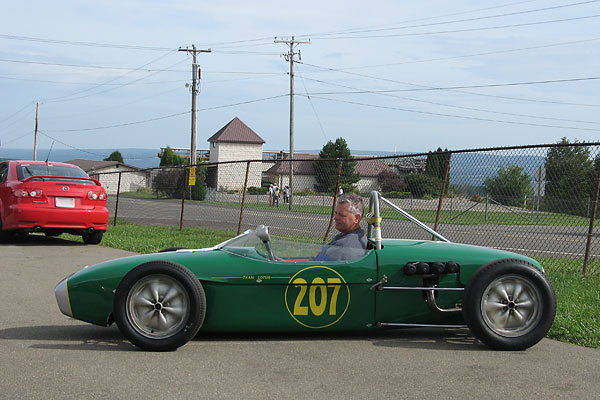
�
Marcus Jones drives this Lotus 18 Junior Race Car
� � Owner: Allen Fine estate� City: Mosely Virginia
� Model: 1960 Lotus 18 Junior
� Engine: 997cc Ford Anglia "Kent" engine�
�
Lotus Finds Success in Formula One
��
The Lotus 16 of 1959 had been uncompetitive in Grand Prix racing. The Coventry Climax FPF�
engine that was available to Team Lotus was very much less powerful than the Ferrari or �
BRM engines, so the Lotus strategy had been to reduce weight and to improve handling so �
they could carry more speed through turns. Simultaneously, they hoped for an aerodynamic �
advantage. Frankly, they didn't meet these goals. The Lotus 16 had excessive understeer, �
and it never placed higher than 6th in a Formula One race. �
�
The big story of 1959 was the success of a different Coventry Climax powered car: the Cooper. �
Cooper won five of nine Formula One races, plus nineteen of nineteen major Formula Two races, �
because apparently Cooper alone recognized the inherent advantages of a rear-engined �
chassis configuration. The era of front-engined Formula cars was ending.�
�
Team Lotus deserves credit for being quicker than most to see the writing on the wall.�
The brand new rear-engined Lotus 18 was ready to race in time for the beginning of the �
1960 season. Indeed, for 1960 the Lotus 18 was absolutely state of the art. Team Lotus �
accomplished all the goals Colin Chapman had set out at the beginning of the 1959 season. �
The 18 was the lightest car in the 1959 Formula One field. At the start of the Belgian �
Grand Prix, the Lotus 18 weighed-in at only 455kg whereas the closest competitor was a �
Porsche at 490kg. The total frontal area of the Lotus 18, including tires and suspension, �
was only nine square feet compared to the Cooper Climax's 9.5. Handling and coefficient �
of drag were similarly outstanding, although it's harder to quantify by what margin. �
�
Of course it doesn't hurt to have a great driver. Sterling Moss qualified fastest and �
then drove an 18 to easy victory at Monaco in May. Moss also qualified fastest for the Dutch �
Grand Prix in June, but during the race one of his wheels was damaged when a lapped car he was �
over taking kicked a kerbstone into his path. Despite stopping for repair, Moss managed to work his �
way back to fourth position. He drove the race's fastest lap in the process. Later in June, �
during practice for the Belgian Grand Prix at Spa, Moss had an accident and was injured, �
and Lotus hopes for the constructor's cup were dashed. Sterling Moss healed and returned to �
driving just in time for the end of the season. The final race was the United States Grand �
Prix at Riverside in November, where Moss once again qualified fastest and went on to race �
victory.�
�
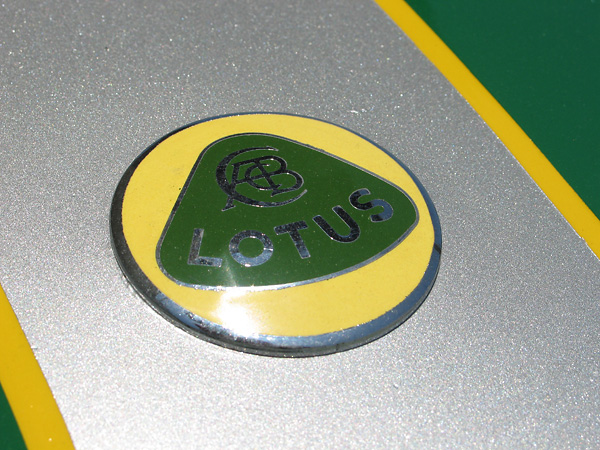
�
"ACBC" is short for Anthony Colin Bruce Chapman, the founder of Lotus.
�
The Formula Junior Story
��
There was a lot more to Lotus than just a Formula One team. From 1959, the Lotus Group�
was comprised of three divisions. Lotus Components Limited was the division�
which built and sold racecars and racecar parts. �
�
It didn't take much work to make the Lotus 18 suitable for Formula Two. They simply �
installed a smaller Coventry Climax engine. Combined build of Formula One and Formula �
Two 18's was 24 cars. But that wasn't all! Lotus Components developed a variant of the �
design for a much lower-power racing class called Formula Junior. About 125 Lotus 18 �
Juniors were built�
�
What is a Formula Junior? Formula Junior rules defined the class as follows: �
"Cars of the Junior formula are one-seater racing cars, whereof the fundamental �
elements are derived from a touring car recognised as such by the F.I.A., �
with minimum production of 1000 units in 12 consecutive months." Maximum engine �
capacity was 1100cc, but cars powered by engines smaller than 1000cc were allowed �
a lower minimum weight of 360kg vs. 400kg (dry). "The gear box must be that of �
an F.I.A. recognized touring car. Complete freedom is left with regard to the �
number and staging of gear ratios." Few if any Formula Junior cars used �
transaxles that came from the same make or model donor car as their engines. �
Renault, Citroen, or VW transaxles were mated to Ford or BMC engines. �
The rules also stated that "The braking system and principles (viz. drum brakes �
or disc breaks) must remain the same as on the car from which is taken the engine." �
�
�
Enjoying this article? www.BritishRaceCar.com is partially funded through generous support from readers like you!
�
To contribute to our operating budget, please click here and follow the instructions.
�
(Suggested contribution is twenty bucks per year. Feel free to give more!)�
�
Except for engine, gearbox, and brakes, the Lotus 18 Junior is very similar to the �
Formula One car. The space frames of both cars integrate a sheetmetal wrapped�
mid-section bulkhead, but the Formula One chassis has a second (similar) bulkhead�
at its extreme rear. Some sources report that the Junior frame used thinner wall �
tubing. The Formula Junior version carries a single fuel tank instead of two tanks, �
it rides on narrower wheels and tires, and it's missing the Formula One car's �
adjustable rear antisway bar.�
�
For the Formula Junior, Lotus wisely chose the new Ford "Kent" four cylinder �
engine which had been introduced in 1959 and was homologated based on its use �
in the Ford Anglia saloon. The engine was peppy, partly on account of its �
oversquare 3.187"/1.906" bore to stroke ratio, its overhead valve 8-port head, �
and its lightweight, low friction, three main bearing crankshaft. Ford rated the �
stock engine at 39hp at 5000rpm and 52.5lb-ft at 2700rpm. Since the Anglia saloon �
only came with drum brakes, the Lotus 18 Junior would be obliged to utilize drum �
brakes too. Lotus chose to mate the Ford engine to a Renault 4-speed gearbox.�
�
�
Allen Fine is deceased, and his estate has decided to sell the car. Marcus Jones will be �
happy to answer any questions from interested buyers. Marcus can be reached by telephone at�
(804) 833-5482. �
�
 �
�
�
�
Features and Specifications
�| Engine: | �997cc Ford Anglia "Kent" engine. Non-crossflow, iron cylinder head. �
Dual Weber 40DCOE carburetors. K&N round tapered air filters (x4). �
Full race camshaft. Standard rockers. �
Lumenition Optronic optical/breakerless ignition system with �
Lumenition high performance coil, used with the Lucas 25D4 distributor.�
Dry sump lubrication system, including a Titan oil pump. | �
| Cooling: | �combination radiator/oil cooler. | �
| Exhaust: | �custom 4-2-1 header. | �
| Transaxle: | �Hewland Mk5 5-speed transaxle with open differential. (First gear is for the �
paddock only.) Tilton single disc clutch. "Lotus" adapter ring.�
(Note: adapter rings, slave cylinders, etc. are readily available from �
Taylor Race Engineering.) | �
| Front Susp.: | �dual wishbone. KONI adjustable coilover shock absorbers. Anti-roll bar. | �
| Rear Susp.: | �driveshaft as upper link. Very long, reversed lower wishbones. Trailing radius rods.�
KONI adjustable coilover shock absorbers. | �
| Brakes: | �(master) dual Lockheed master cylinders with bias bar. � (front) drum. � (rear) drum. | �
| Wheels/Tires: | �Lotus "wobbly web" six-stud magnesium wheels. Dunlop Racing "204" tires, 15x4.5 front / 15x5.0 rear. | �
| Electrical: | �Tilton Super Starter. Wet cell motorcyle battery. | �
| Instruments: | �(left to right) Westech dual EGT gauges (700-1700F),�
Smiths coolant temperature gauge (90-230F), �
Jones mechanical tachometer (1000-9000rpm), �
Smiths oil pressure gauge (0-100psi), | �
| Fuel System: | �Fuel Safe Systems fuel cell. Facet fuel pump. | �
| Safety Eqpmt: | �Simpson five point cam-lock safety harness with Sabelt shoulder pads. �
Lifeline fire suppression system. �
Quick release steering wheel hub. 50 LED rain/brake light. | �
| Weight: | �885lb. | �
| Racing Class: | �Formula Junior / SVRA FJ2 | �
Engine Installation
��
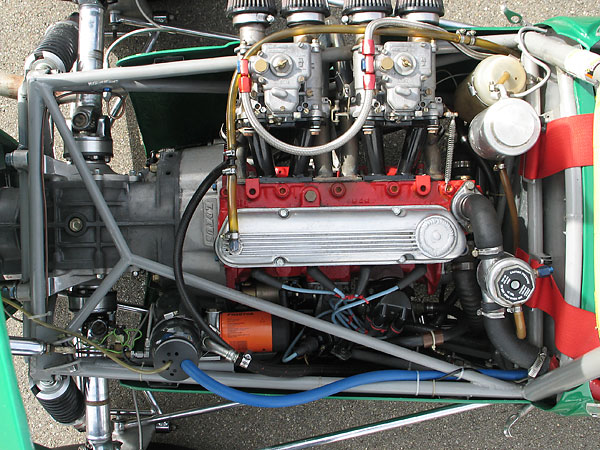
�
997cc Ford Anglia "Kent" engine.
�
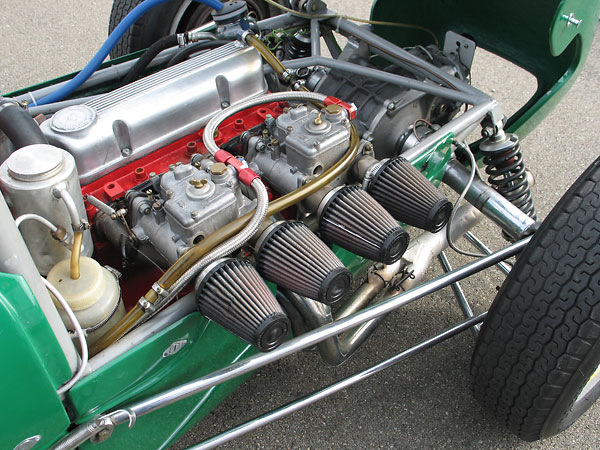
�
This engine was newly introduced in 1959 for use in Ford of Britian's Anglia (105E) saloon model.
�
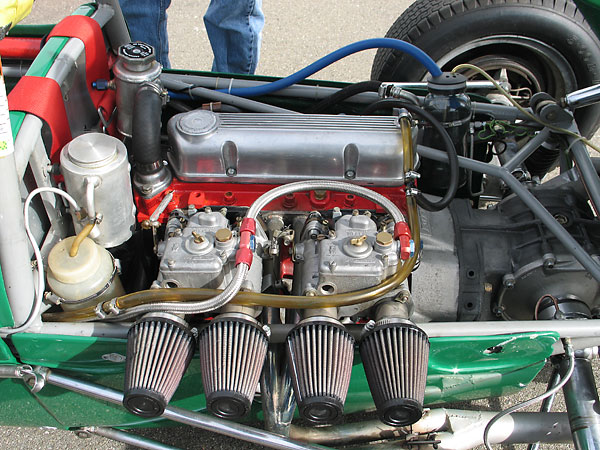
�
Dual Weber 40DCOE carburetors.
�
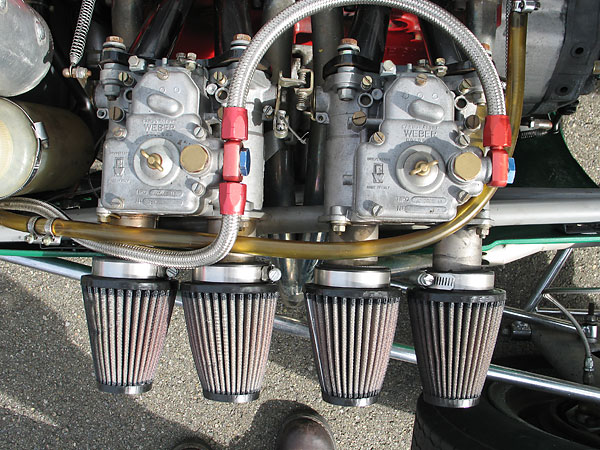
�
K&N round tapered air filters (x4).
�
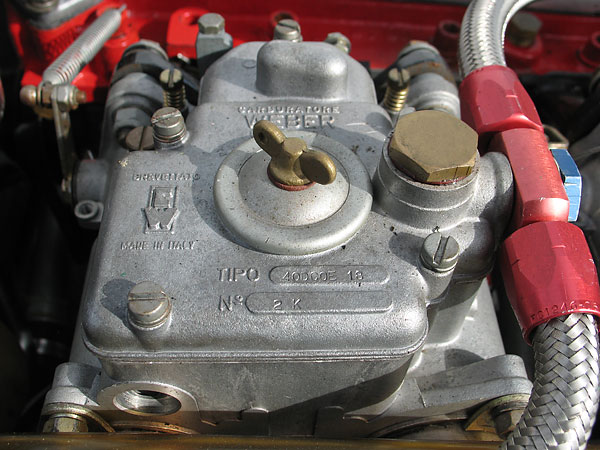
�
The Webers are stamped "40DCOE18", where the 18 suffix indicates their initial set-up including jetting.
�
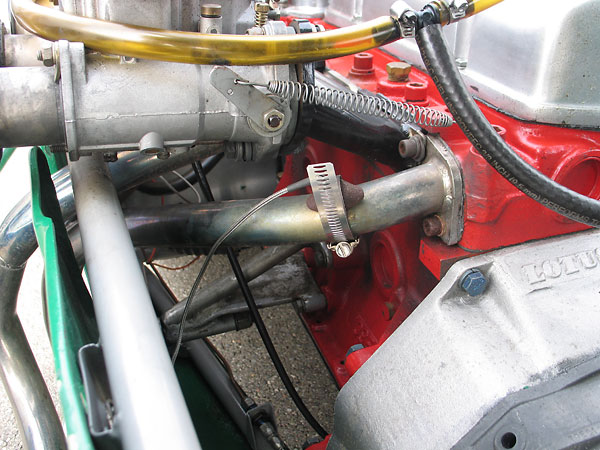
�
Exhaust gas temperature sensor, mounted to the exhaust header.
�
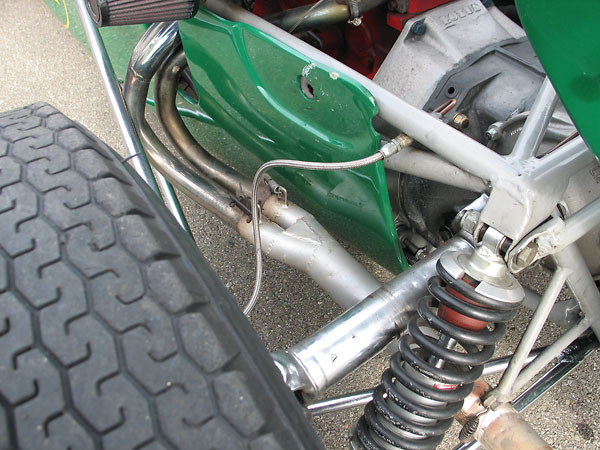
�
Four-into-Two-into-One (aka: "Tri-Y") exhaust header suits the engine's 4-2-1-3 firing order.
�
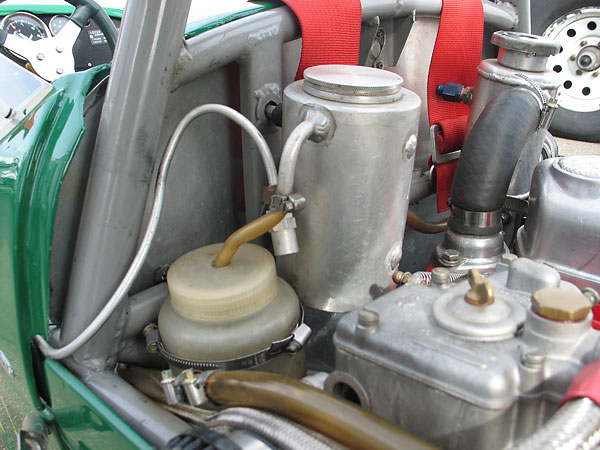
�
This is just a coolant overflow bottle and a catch tank.
�
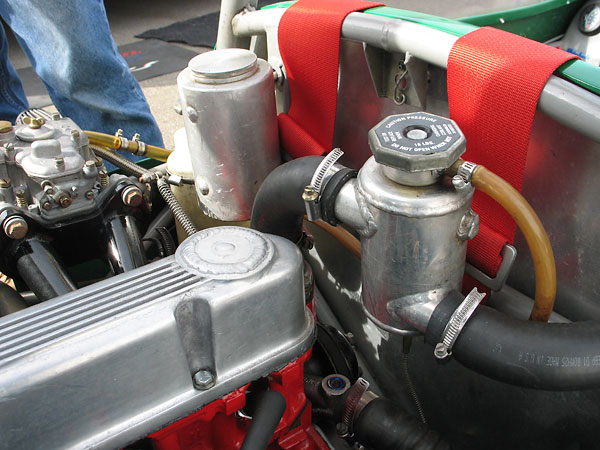
�
Coolant header tank, with pressure cap at the high point in the system
�
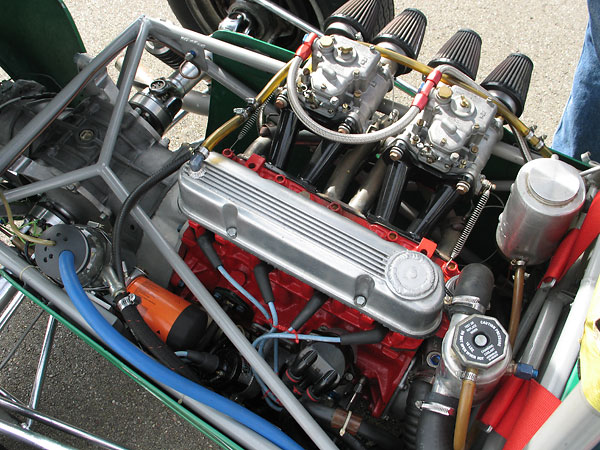
�
A better view of the fabricated steel intake manifolds.
�
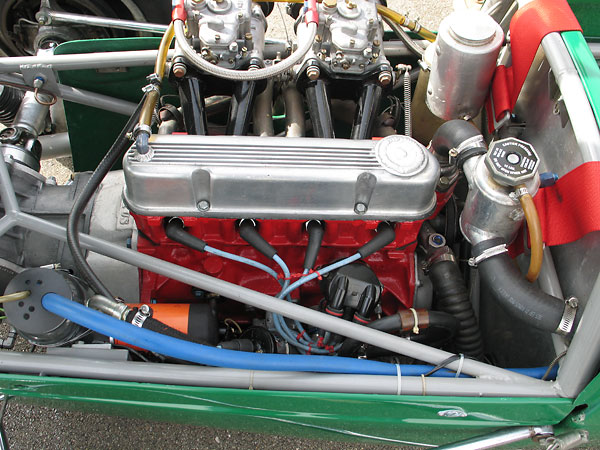
�
Lucas 25D4 distributor, upgraded with Lumenition "Optronic" optical pick-up breakerless ignition module.
�
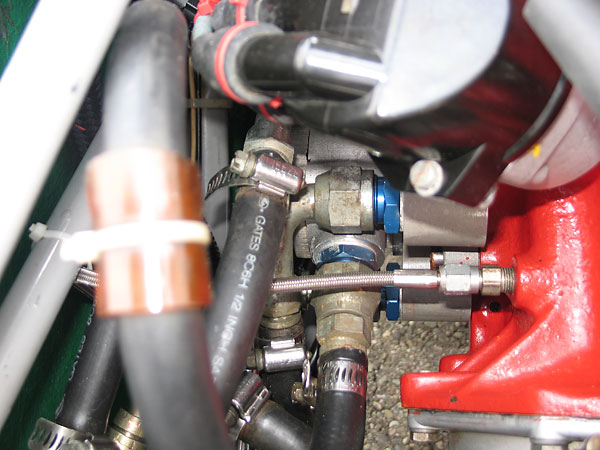
�
Oil pressure gauge port, and plumbing for oil cooler / remote filter.
�
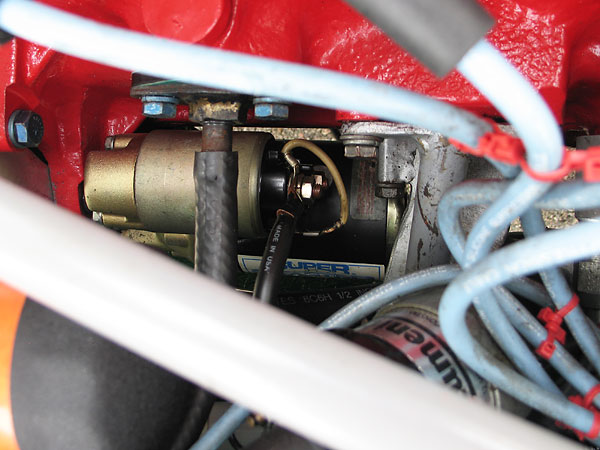
�
Tilton Super Starter.
�
Transaxle
��
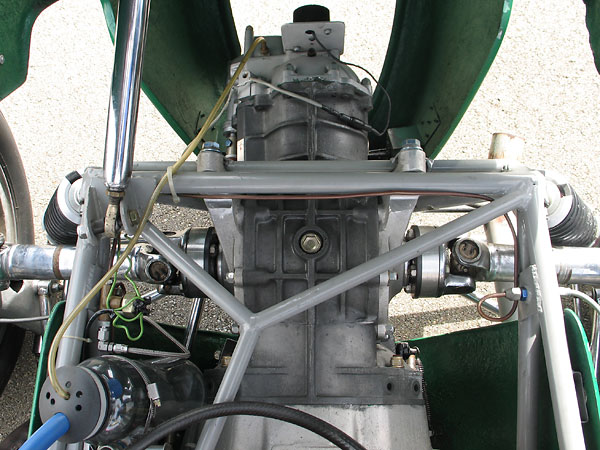
�
Hewland Mk5 5-speed transaxle with open differential.
�
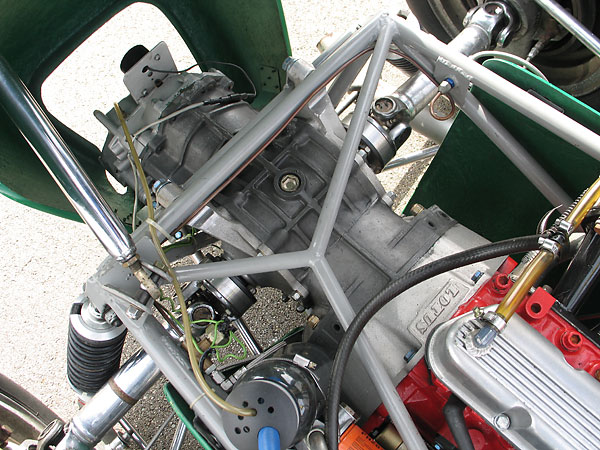
�
Lotus 18 Juniors came with Renault Dauphine (Type 318) 4-speed gearboxes. The Hewland transaxle in this
�
car is a big upgrade. Englishman Mike Hewland started modifying Volkswagen transaxles for racing use in
�
1957. Much of Hewland's early business was for Formula Juniors, and many cars were converted. In 1961,
�
Lotus started offering Hewlands as optional equipment. Still, some vintage racing clubs forbid the upgrade.
�
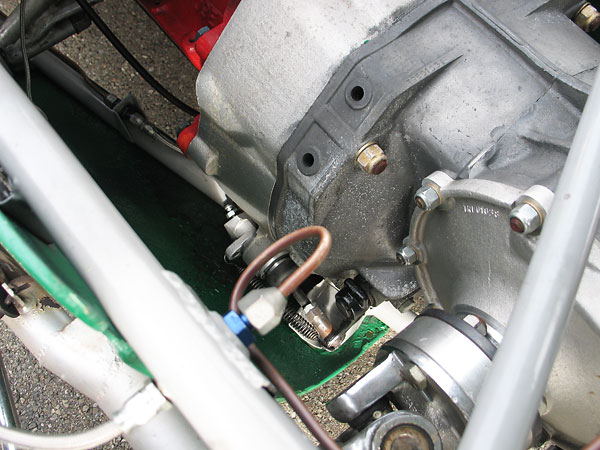
�
The clutch slave cylinder (7/8" bore) and transaxle adapter ring are from Taylor Race Engineering.
�
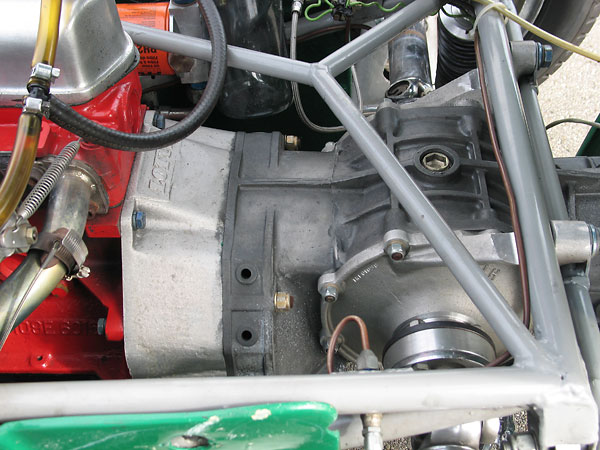
�
The transaxle appears to be a neat fit. We understand it took a lot of wiggling to get it into place.
�
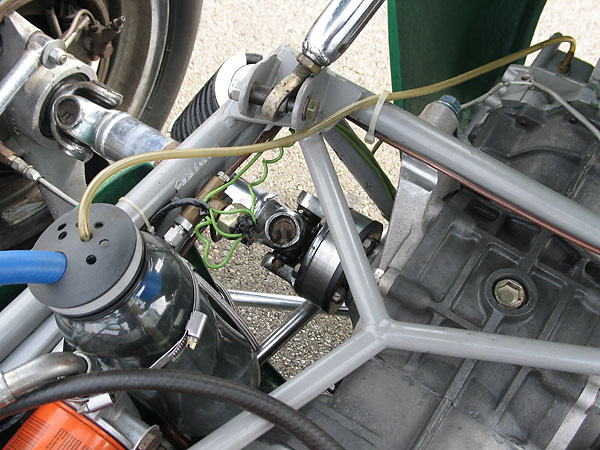
�
The spherical rod end bearing (a.k.a.: "Heim joint" in U.S.A. or "Rose joint" in Great Britian) at the
�
top of this photo is part of a detachable roll hoop brace. The brace, and indeed the roll hoop itself,
�
are relatively modern concessions to safety. Lotus didn't provide any rollover protection at all. Heim
�
joints provide a convenient way to adjust the length of all sorts of radius rods. Notice that you don't
�
see a Heim joint in the very top, lefthand corner of this photo. Why not? We'll get to that!
�
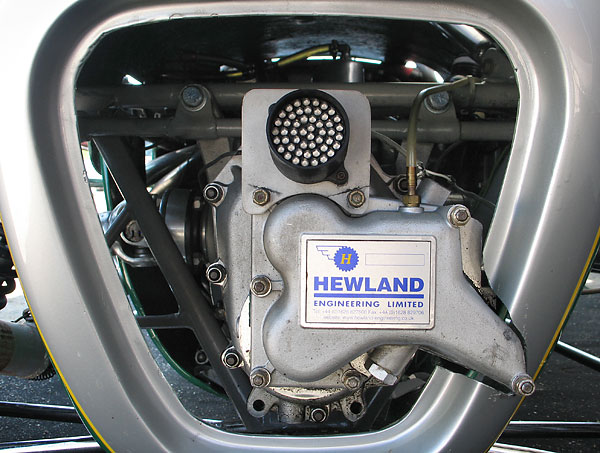
�
This bright, rugged 50-LED lamp is marketed as "The Ultimate Tail/Brake Light."
�
�
Front Suspension
��
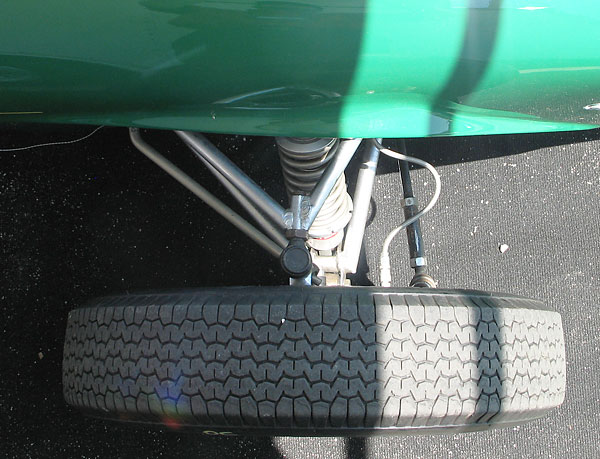
�
Dual wishbone front suspension.
�
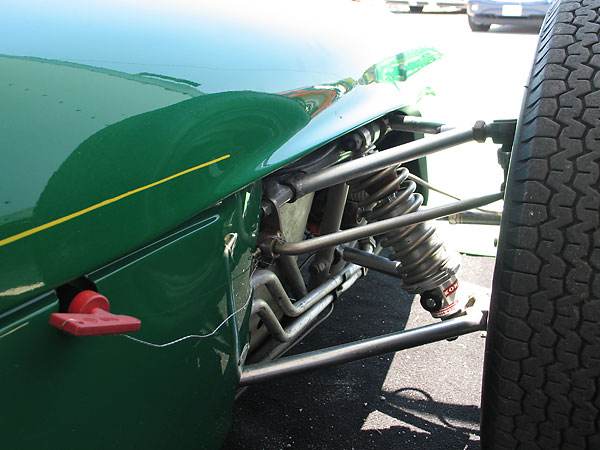
�
The original Armstrong shock absorbers have been replaced with adjustable KONI shock absorbers.
�
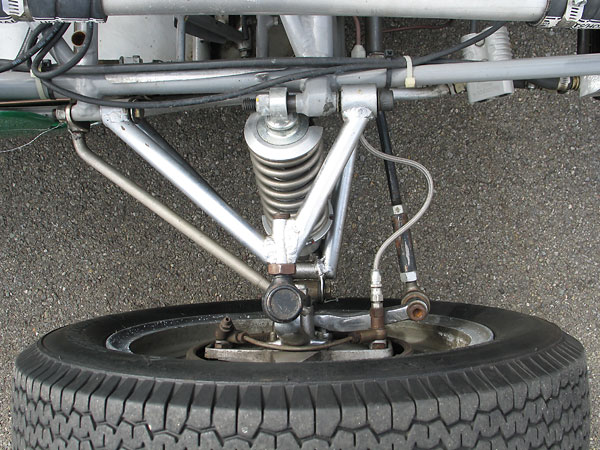
�
To adjust caster angle, one disconnects the top wishbone and then adds or removes shims.
�
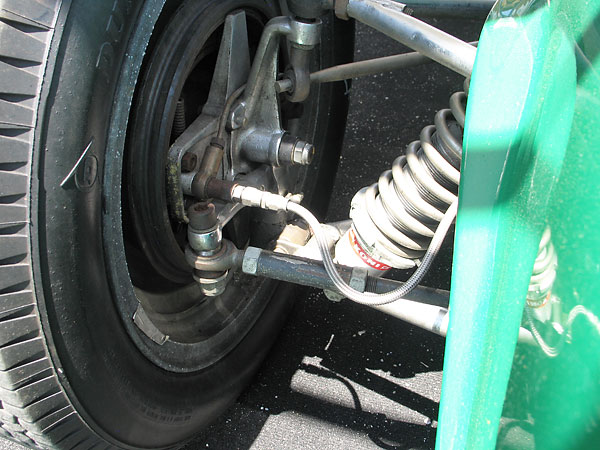
�
Steering links originally had conventional tie rod ends. Heim joints facilitate more precise adjustment.
�
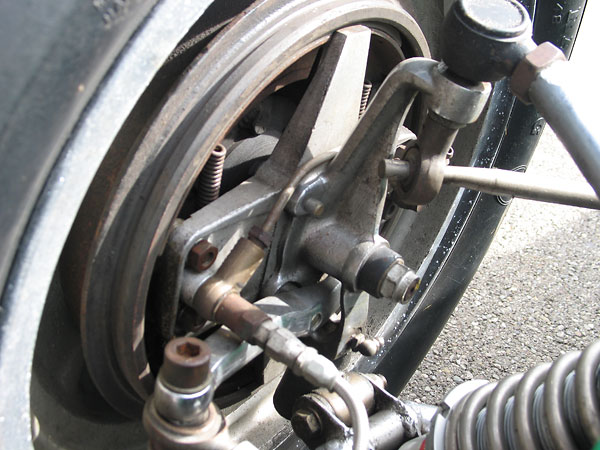
�
Finned aluminum ("Alfin") brake drums are common on Formula Junior cars, but this one has iron drums.
�
The Formula One version of the Lotus 18 raced with Girling disc brakes on all four corners.
�
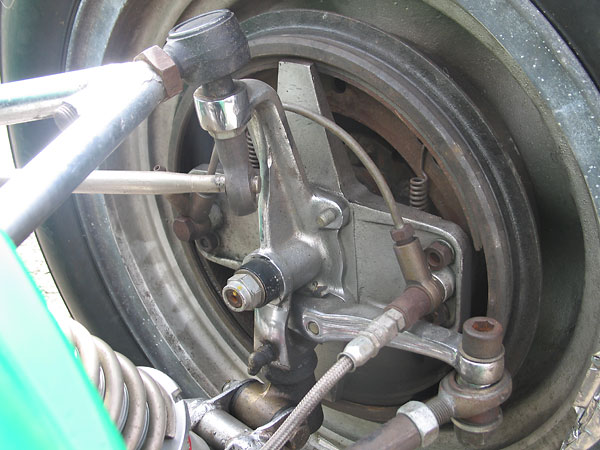
�
Feeding the front anti-roll bar through a Heim joint bearing is cleverly light and simple. It's a Lotus trick
�
that was also used on the Formula One Lotus 18's. Downside: roll stiffness isn't easily tuneable.
�
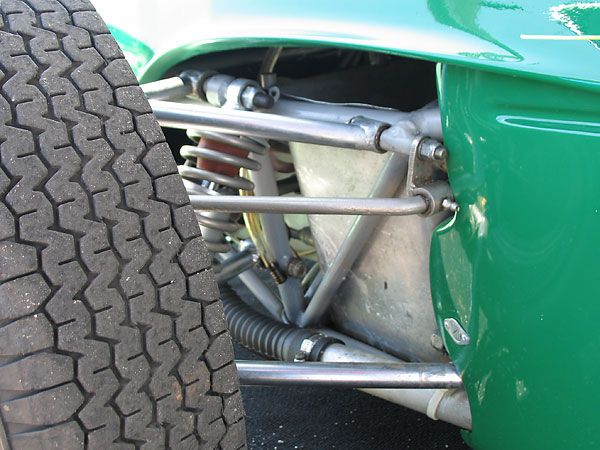
�
Anti-roll bar mounting bracket.
�
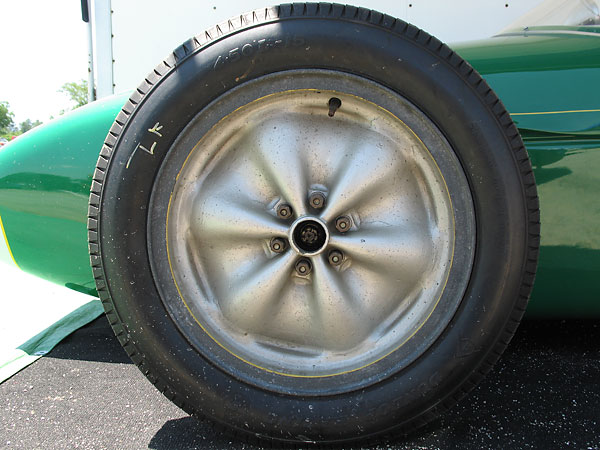
�
In 1958, "wobbly web" convoluted magnesium wheels became a distinctive Lotus feature. Lotus wobbly web
�
wheels proved to be both lighter and stiffer than spoke wheels. Soon, all competitive international race teams
�
switched to cast magnesium wheels. (Ferrari was last, in 1961.) Lotus wobbly web wheels were mounted on
�
studs to save weight compared to old-fashioned knock-offs. This change was facilitated by tire improvements;
�
by 1958, tire changes were no longer common during races. Why not use aluminum wheels? Magnesium
�
is about half as strong as aluminum, but it only weighs about two-thirds as much per unit of volume.
�
Rear Suspension
��
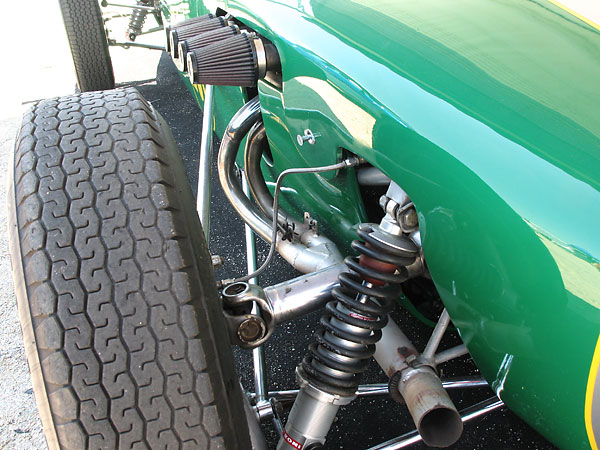
�
In 1959, Cooper started a landslide in Grand Prix development by putting their engine behind the driver.
�
Lotus was first to follow Cooper's lead, but did so with substantial technical refinements. Where Cooper
�
had used a transverse leaf spring for the rear suspension, Lotus used coilover shock absorbers. To save
�
weight and add simplicity, Lotus tried something tricky: they employed the driveshafts as de facto upper
�
suspension links instead of having separate wishbones (as in the front suspension).
�
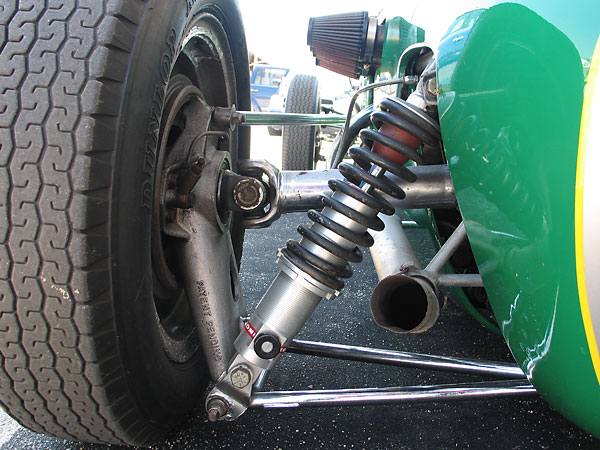
�
Complications? The location of u-joints on the driveshafts were now suspension pivot points, so their
�
location was critically important. Also, bearings in the transaxle would have to withstand axial loads.
�
On the other hand there was no need for splined joints on the driveshafts. (Splined joints add cost and
�
can cause binding. In 1961 Lotus tried a different approach. They added upper wishbones, but made
�
fixed length shafts work by using them with donut-shaped rubber couplings to accomodate plunge.
�
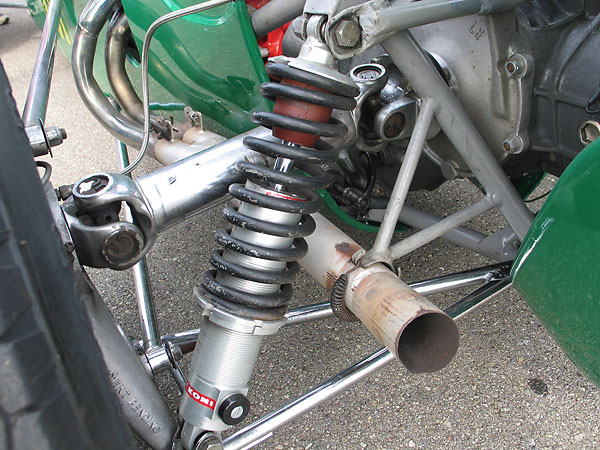
�
Notice here that the upper suspension link (i.e. the halfshaft) is much shorter than the lower link. With
�
this geometry, the rear wheel will tilt toward the body (i.e. develop "negative camber") as it moves
�
upwards in bump. But when cornering, the chassis of the car will tilt outward and the net result will be
�
that the tire stays substantially perpindicular to the road surface for better grip.
�
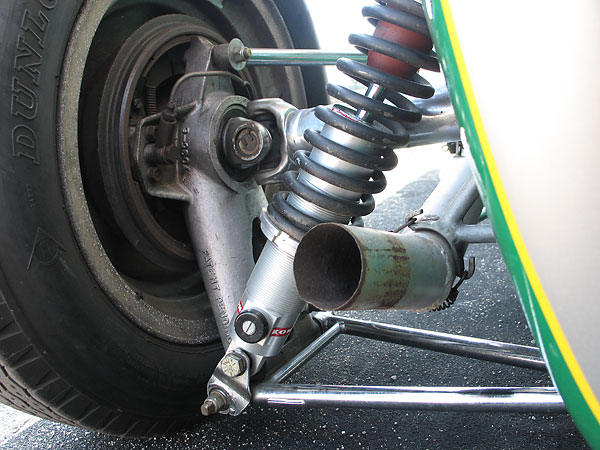
�
Lotus designed the 18 to have both front and rear nominal suspension roll centers about and inch or so
�
above the ground. Compared to previous Grand Prix cars, weight transfer from inner to outer wheels during
�
cornering was dramatically reduced. However, this design was a bit of a compromise because the distance
�
from nominal roll center to center of gravity (i.e. the "roll couple") was increased. In simple terms, the car's
�
body would sway sideways more than other cars when turning. To mitigate this, Lotus equipped the Lotus
�
18 Grand Prix cars with both front and rear anti-sway bars. (The rear bars were adjustable.) However, Lotus
�
apparently decided against providing the Lotus 18 Juniors with rear anti-sway bars.
�
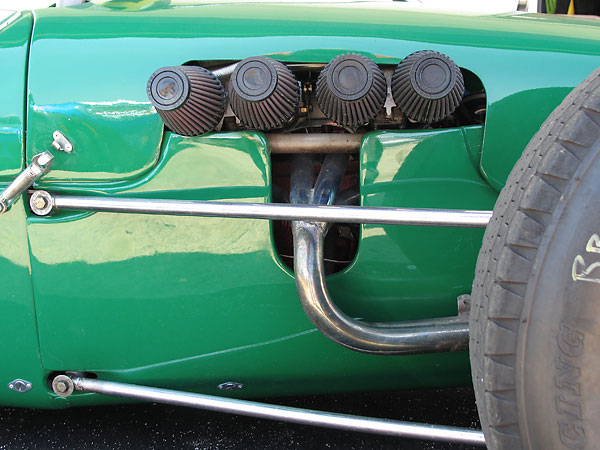
�
Lotus made these trailing links as long as feasible to help minimize rear steering effects. Notice that their
�
length isn't adjustable, so they have to be precisely made and they don't facilitate suspension tuning.
�
(Use of Heim joints on suspension radius rods was pioneered by the Cooper Car Company in 1958.)
�
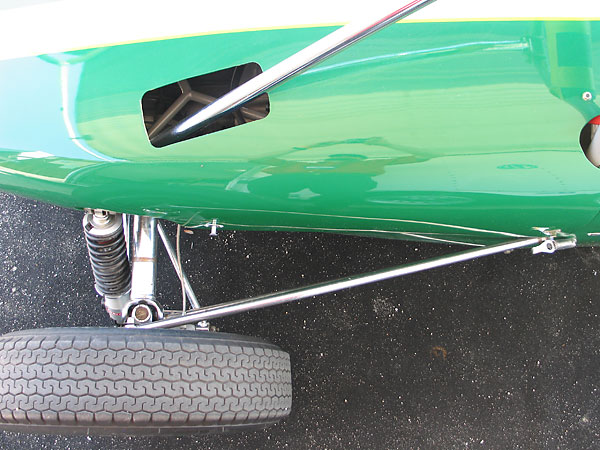
�
Trailing radius rods.
�
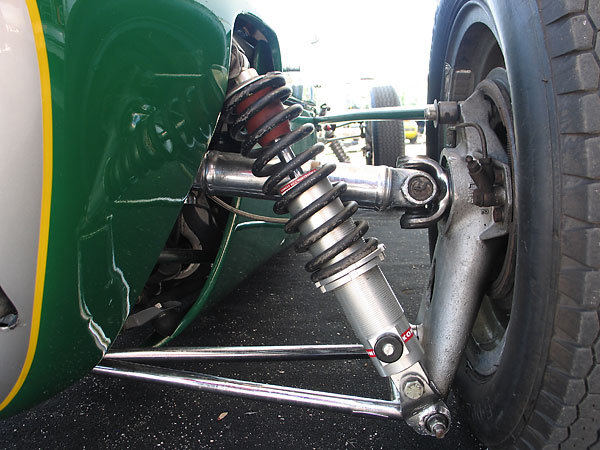
�
KONI adjustable coilover shock absorbers.
�
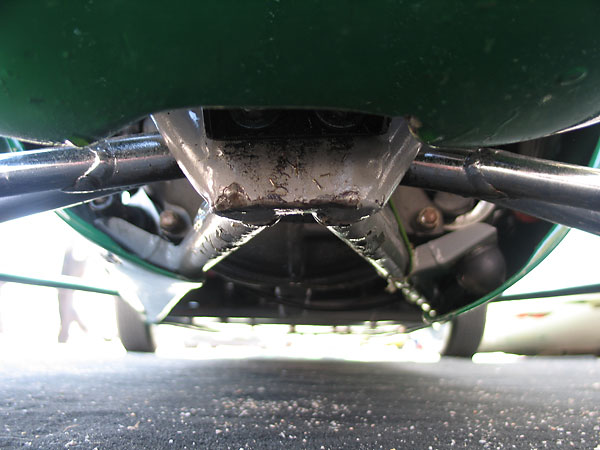
�
Lower inboard suspension pivot points.
�
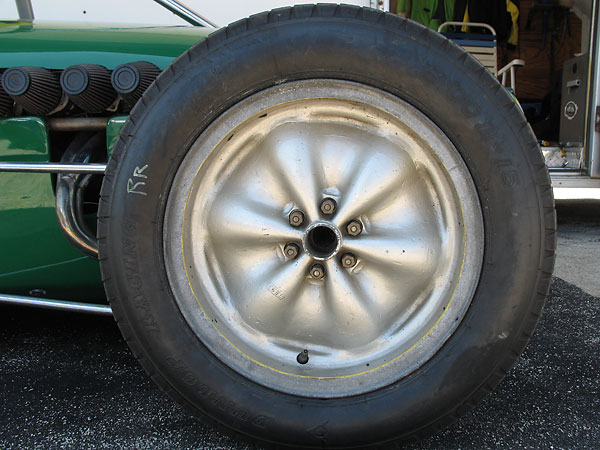
�
The Formula Junior races on 15"x4.50" (front) and 15"x5.00" (rear) Dunlop Racing "204" tires. However,
�
in its Formula One version the Lotus 18 raced on 15x5.00" (front) and 15x6.50" (rear) Dunlop "R5" tires.
�
�
Miscellaneous / Chassis
��
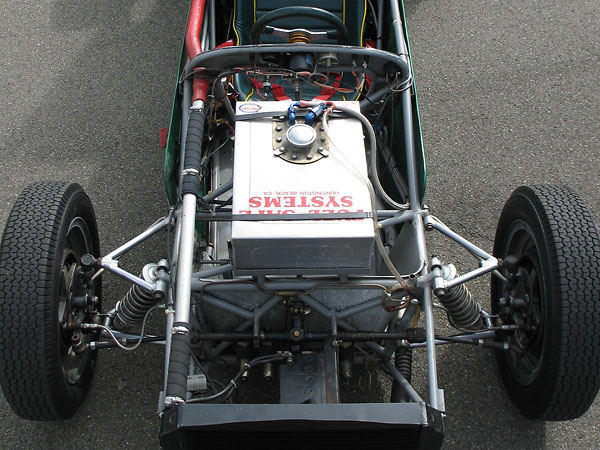
�
Fuel Safe Systems fuel cell.
�
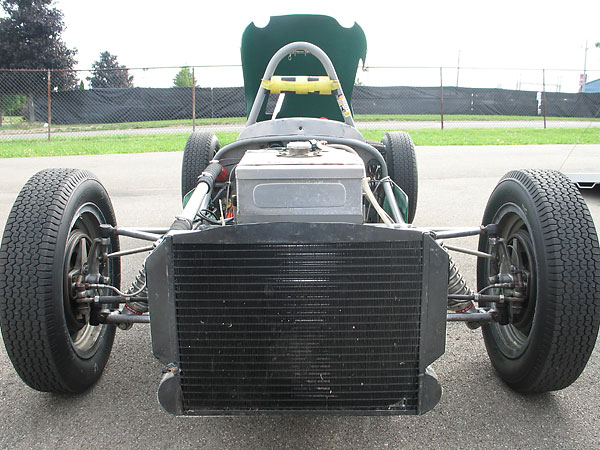
�
Combined radiator (above) and oil cooler (below).
�
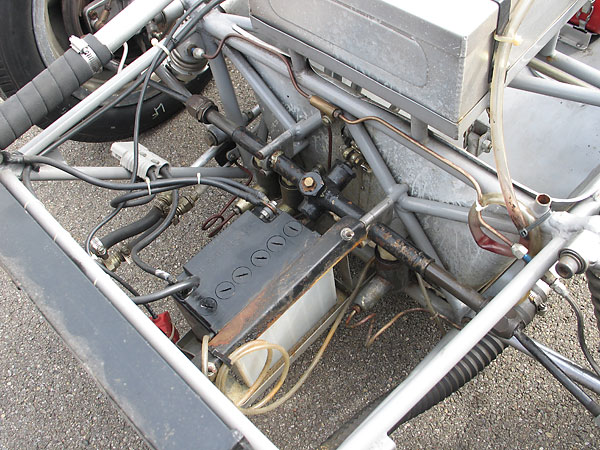
�
Wet cell motorcyle battery.
�
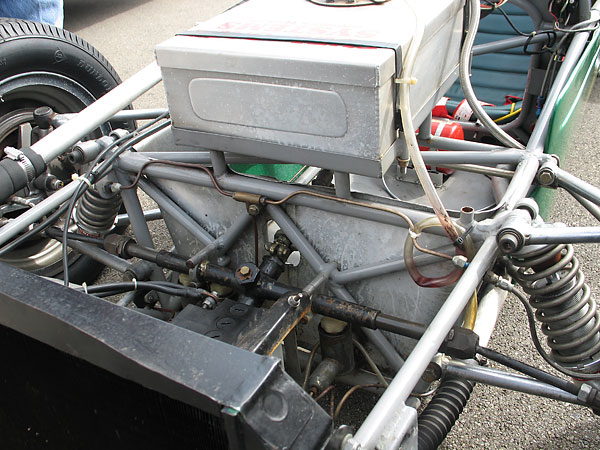
�
Lightweight steering rack.
�
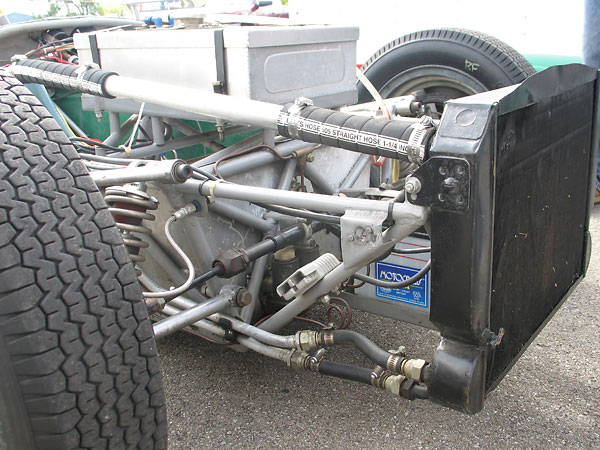
�
The front section of the body is mounted on just a handful of Dzus quarter-turn fasteners.
�
Interior
��
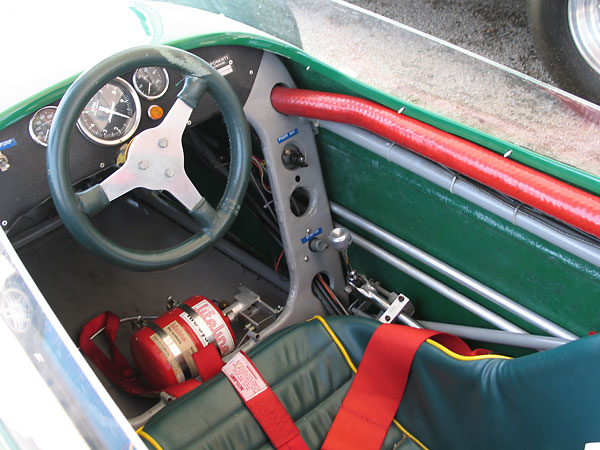
�
Lotus used green gelcoat when they made the Lotus 18's fiberglass body panels.
�

�
The quick release steering wheel hub is a modern safety feature.
�
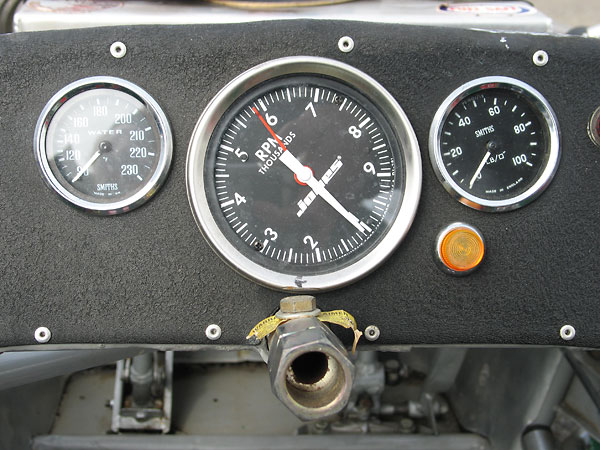
�
Smiths coolant temp gauge (90-230F), Jones tach (1000-9000rpm), Smiths oil pressure gauge (0-100psi).
�
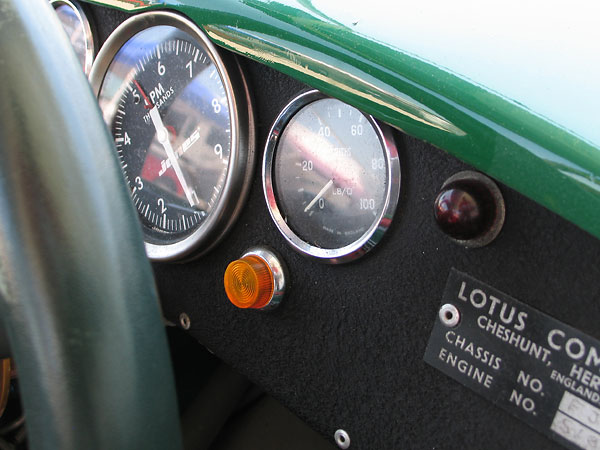
�
�
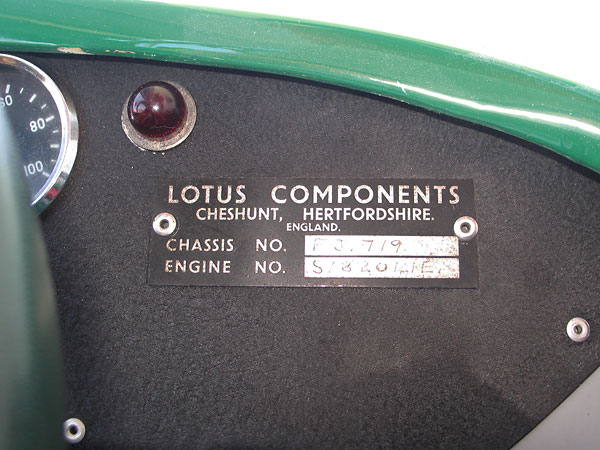
�
LOTUS COMPONENTS
�
Cheshunt, Hertfordshire. England.
�
Chassis No. FJ719, Engine No. S182041E
�
�
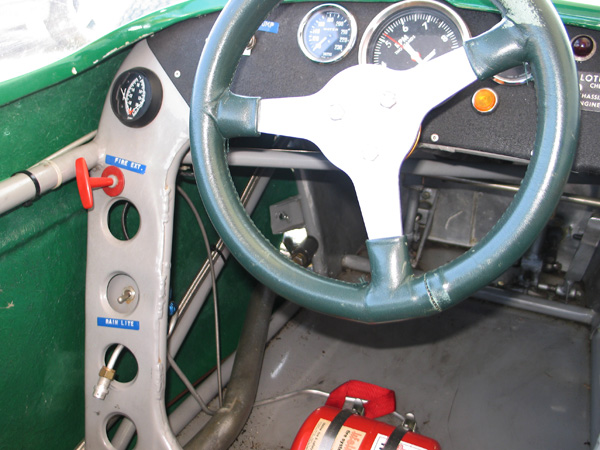
�
Westech dual EGT gauge, fire suppression switch, rain light switch, fire suppression spray nozzle.
�
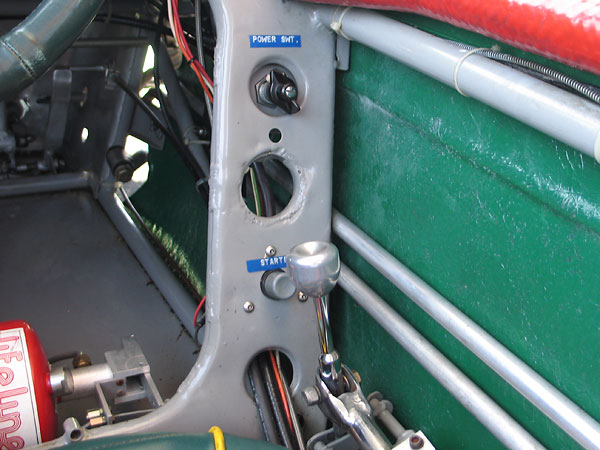
�
Lucas power and starter switches. Note: the original (Renault) shifter was located on the lefthand side.
�
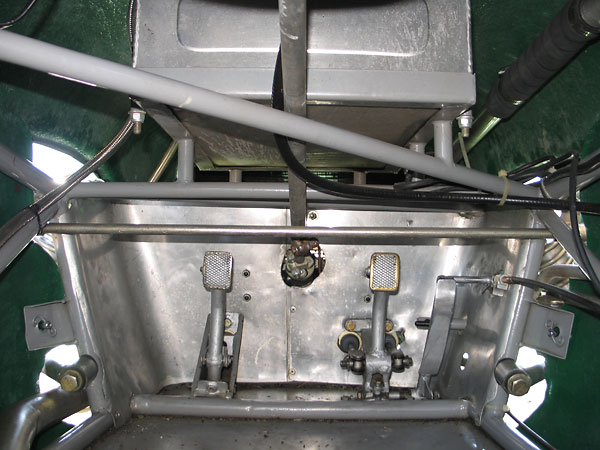
�
Foot box.
�
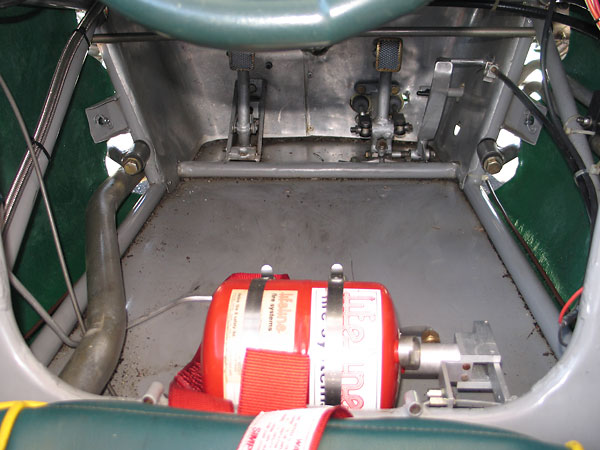
�
Lifeline fire suppression system.
�
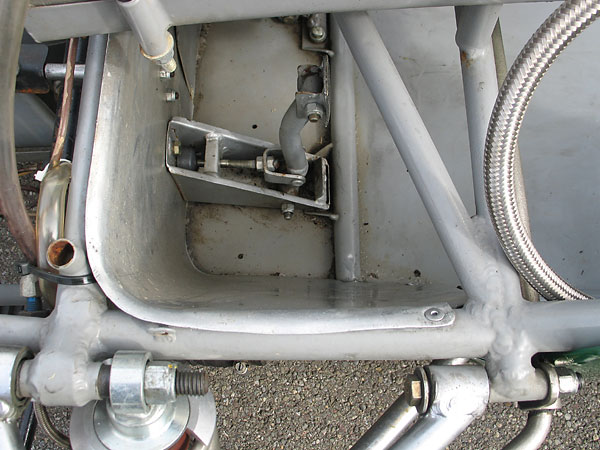
�
Clutch pedal.
�
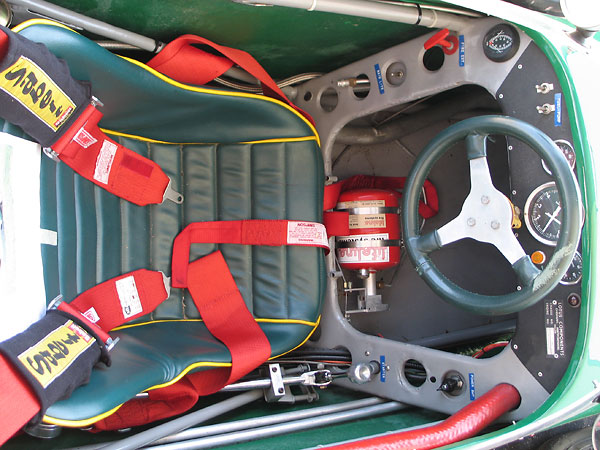
�
Simpson five point cam-lock safety harness with Sabelt shoulder pads.
�
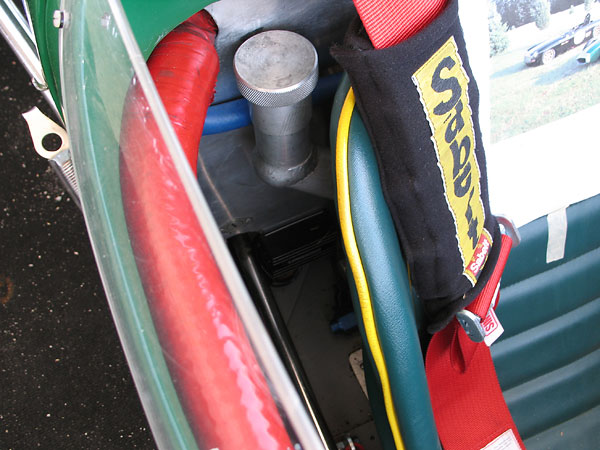
�
The oil reservoir for the dry sump lubrication system is mounted behind the seat.
�
In the shadow: the Lumenition Optronic ignition module.
�
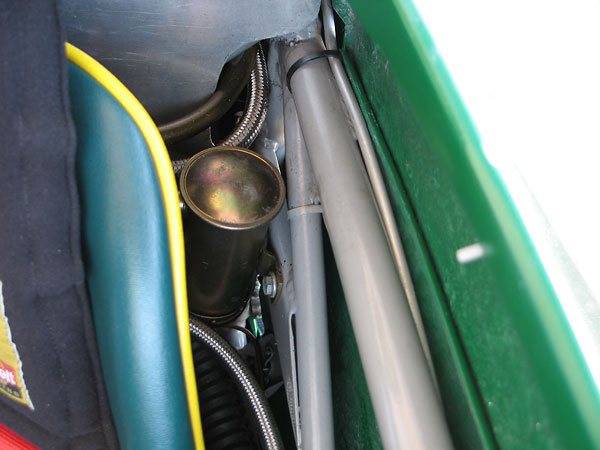
�
Facet fuel pump.
�
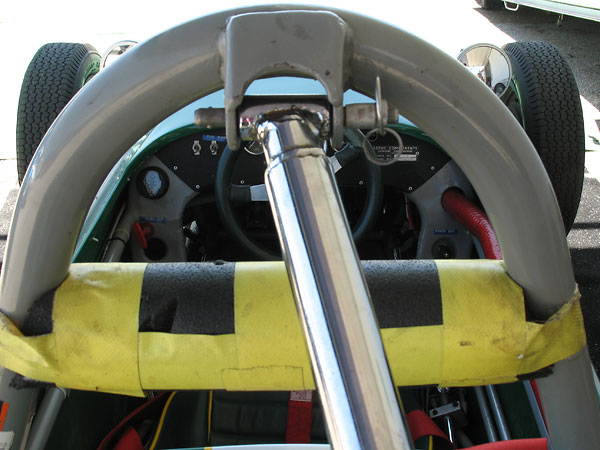
�
Removeable quick-release "Pip pin" comes out, and then the roll-hoop brace can be swung rearward.
�
�
Exterior
��
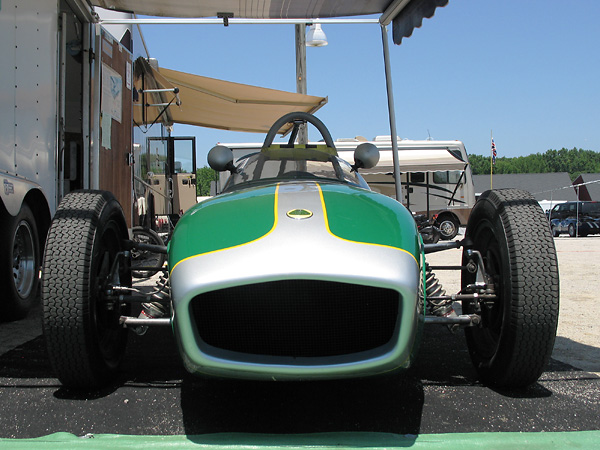
�
�
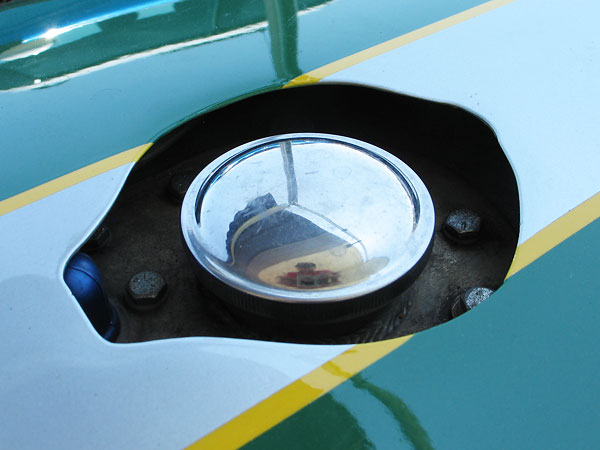
�
A "LeMans Style" flip-open fuel cap would have been original.
�
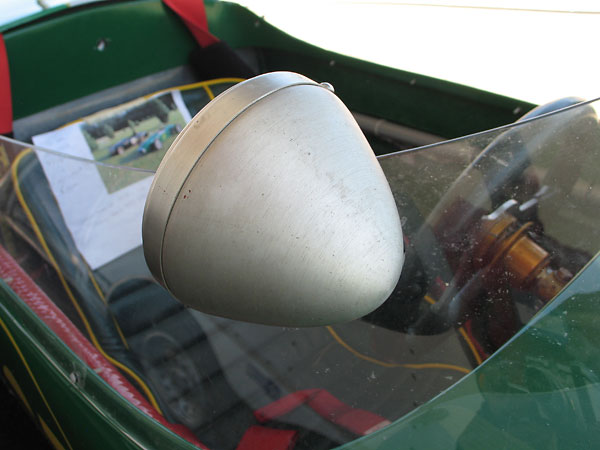
�
GT Classic mirror.
�
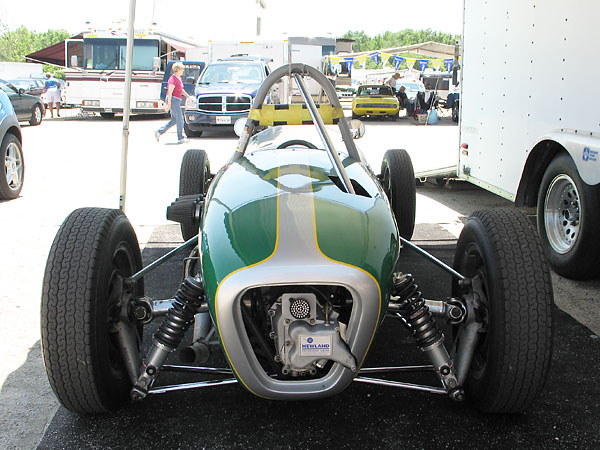
�
�
�
All photos shown here are from June 2009, when we viewed the car at The Heacock Classic Gold Cup at �
Virginia International Raceway, or from September 2009 when we viewed the car at The US Vintage Grand �
Prix at Watkins Glen. All photos by Curtis Jacobson for BritishRaceCar.com, copyright 2009. �
All rights reserved.
�
| If you liked this article, you'll probably also enjoy these: | �|||||
 | �
Jay Nadelson 1957 T43 | �
 | �
Jeff Snook 1956 XI LeMans | �
 | �
Dick Leehr 1968 51c | �
| You're invited to discuss anything you've seen here on The British Racecar Motorsports Forum! | �|||||
�
Notice: all the articles and almost all the photos on BritishRacecar.com are by Curtis Jacobson.
�
(Photos that aren't by Curtis are explicitly credited.) Reproduction without prior written permission is prohibited.
�
Contact us to purchase images or reproduction permission. Higher resolution images are optionally available.
�

 �
�